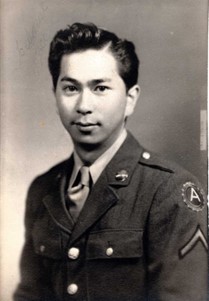
George Yaki
Private First Class
442nd Regimental Combat Team
100th Battalion, D Company
George Yaki was born on June 9, 1922, in San Francisco, California. He was the only son and youngest child of Yuguma and Ide (Osako) Yaki. His sisters were: Meri (died age 6), Iku, Taeko Joyce, Sachiko, and Fumiko Barbara. His parents emigrated from Kagoshima Prefecture, Japan. Yuguma arrived on September 11, 1903, on the Hong Kong Maru. Ide arrived from Hioki District, Kagoshima Prefecture, on the Chiyo Maru on August 8, 1911, and they were married shortly thereafter.
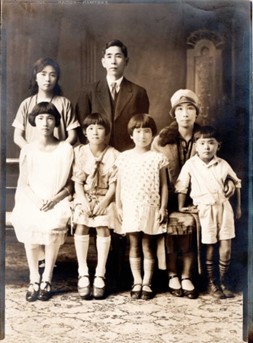
In 1930, the family lived at 2242 Fillmore Street in San Francisco. Father Yuguma was employed cleaning private homes in apartment buildings. George lived for a short time that spring at nearby 2252 Fillmore with Minerva Sicily, a professor of fine arts.
Yaki family about 1926
In 1940, the family was still in the same house and Yuguma (also known as Harry) was a general laborer, Ide was a maid for a private family, and the oldest daughters also worked. George graduated from Lowell High School that June. He had lettered in track and was a member of Big Brothers. He had planned to attend college and study journalism, and that fall he enrolled at San Francisco Junior College to study floriculture.
After the attack on Pearl Harbor on December 7, 1941, life changed. In the spring of 1942, the Yaki family was evacuated to the Santa Anita WCCA Assembly Center in Arcadia, a suburb of Los Angeles. While there, on June 20 George signed his draft registration card at Local Board No. 190, Los Angeles County. He was 5’6¾” tall and weighed 130 pounds. His point of contact was Heaton Twigger of 942 Talbot Street in Albany, his home address was 2242 Fillmore Street, and his employer was the Santa Anita WCCA Center.
A few months later, on October 9, 1942, the family was incarcerated in the Central Utah WRA Center, known also as Topaz. While there, they lived in Block 33-10-C. The family was released as follows: Yuguma, Ide, and Sachiko to San Francisco on October 11, 1945; Taeko to Milwaukee, Wisconsin, for employment on July 26, 1943; Fumiko Barbara to Chicago, Illinois, for employment on March 19, 1943; and George to Roosevelt, Utah, for employment on March 23, 1943.
George enlisted in the U.S. Army in Salt Lake City, Utah, Local Board No. 11 on May 11, 1943. His civilian occupation was listed as “Chauffeurs/drivers of bus, taxi, truck, tractor.” His weight was 107 pounds. After going through the Army processing center at nearby Camp Douglas, he was assigned to the 442nd Regimental Combat Team and sent to Camp Shelby, Mississippi, for training. The Army authorized his transportation by train from Delta, Utah, to Hattiesburg, Mississippi, via Kansas City and St. Louis, Missouri, and Jackson, Mississippi. He was given a voucher for a Pullman berth in Tourist Class to Jackson and Coach from there to Hattiesburg. The voucher was issued May 7 and valid until May 18.
He arrived at Camp Shelby on May 14, was assigned to 1st Battalion, D Company, and joined the other new soldiers who had been arriving for training since April. That fall, the 100th Infantry Battalion was fighting in Italy and incurring so many casualties that they were in need of replacement troops. George was in the first group of replacements sent to the 100th from the 442nd. Ten officers and 165 men left Camp Shelby on January 19, 1944, and arrived at Fort George G. Meade, Maryland, for transfer to Italy. They left for the Theater of War on February 22. On March 8, 1944, he wrote to his family while they were enroute to Italy:
It’s pretty cold here in North Africa, so I am making good use of the sweater you knitted me. The sun is out, but the wind blowing is cold. I can see rich green fertile land in the distant valley. A pretty sight with the mountains and all. We get oranges here, so the weather must be like that of California. I saw a movie titled “The Philadelphia Story” at an open-air theater and it wasn’t bad. I recall seeing it at home. Today we were treated to a coke. Imagine, way over here. I haven’t touched any of the watery wine yet, and I don’t think I’ll ever because you can’t trust it. I’ll wait to have some of that Rome wine. My health is good and I only hope that you all are in the best of health and spirits. I had a shower today. Ration one a week. Well, I’m at the end, so goodbye for now. Your loving son, George
After the letter passed through the military censors, it was postmarked March 18.
Yaki and the other replacements (151 of the 165 men) left North Africa and arrived to the 100th at a rest camp at San Giorgio near Benevento. The 100th had been there since March 10. On March 24 the 100th left Naples (about 50 miles away) and boarded LSTs for the Anzio beachhead, a large area near the seaside town that had been secured by the Allies in January. They arrived there on March 26.
On May 24, the 100th made its breakout from Anzio and was engaged in the battles south of Rome. After the fall of Rome to the Allies, on June 5 the 100th was sent to a large bivouac area in Civitavecchia, 50 miles north of Rome. While there, they met up with the newly arrived 442nd RCT and became their “1st” Battalion, as the 442nd’s 1st Battalion had been depleted by sending replacements to the 100th in the preceding months and by transfers out to companies in the 442nd’s 2nd and 3rd Battalions.
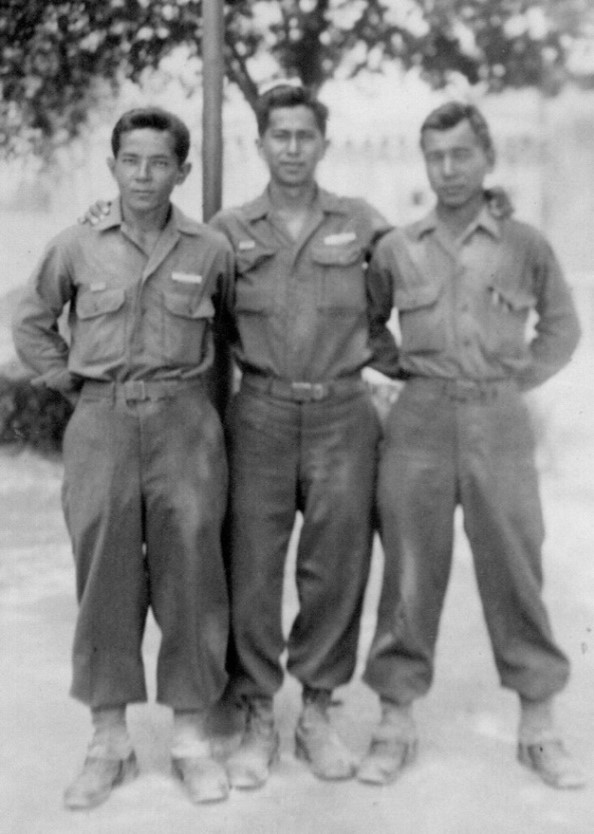
The 100th and 442nd first went into combat together on June 26 near Suvereto. After nearly a month of intense fighting, the Combat Team was pulled from the front lines and sent to a rest area near Vada on July 21. While there, George went on a short furlough to Rome. On August 16, the unit was moved back to the lines at the Arno River.
Yaki (center) with buddies Shiroma and Cash in Rome, August 7, 1944
The Combat Team left for France on September 27. Once they arrived in Marseilles, they were in a bivouac area in nearby Septèmes until October 9, when they convoyed 500 miles north to fight in the Rhineland-Vosges Campaign to liberate France from the Nazis.
In October-November 1944, the 442nd liberated the important road junction of Bruyères, followed by Biffontaine and the famous “Rescue of the Lost Battalion” – the 1st Battalion of the 141st (Texas) Infantry Regiment that had advanced beyond its support, become surrounded by the enemy, and was unable to extricate itself.
Following the Vosges, Pfc. Yaki was with the 442nd during the Rhineland-Maritime Alps Campaign in southern France from November 1944 to March 1945. During that last month in southern France, he and fellow soldier Earle Tucker were assigned to do a “courier run,” likely delivering important papers. Yaki painted the words Marie, Amour, and Lisette across the hood of their jeep, and Courier on the front. George wrote that they had great fun.
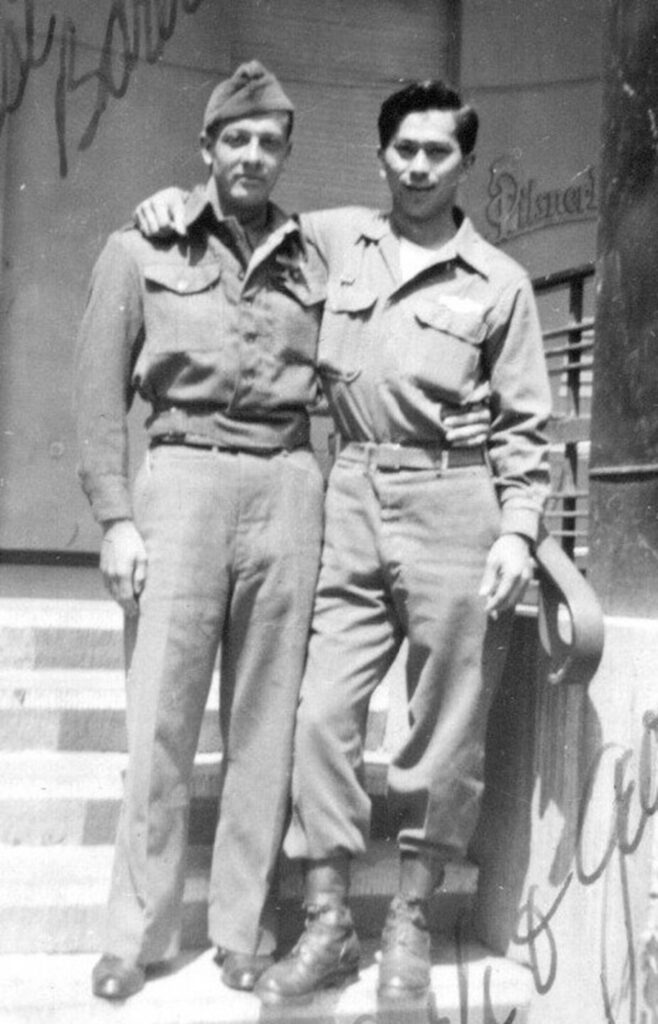
The 442nd returned to Italy on March 25, 1945, for the Po Valley Campaign, leading to the end of the war in May. It is not clear if George returned to Italy with the 442nd. Likely not, as he was in Weimar, Germany, on V-E Day, May 8, 1945, and there again two months later with his courier buddy, Earle Tucker.
Yaki and Tucker, July 4, 1945, at their hotel in Weimar, Germany
Below: Yaki in Bad Godesberg, Germany, July 4, 1945
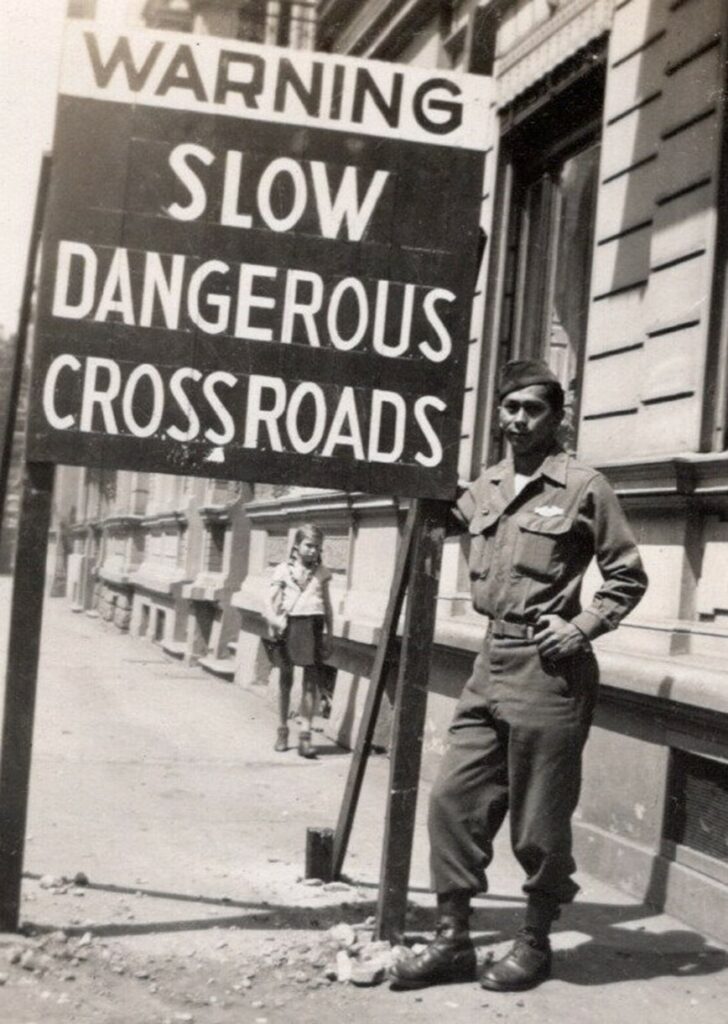
For his wartime service, Pfc. George Yaki was awarded the Bronze Star Medal, Good Conduct Medal, American Campaign Medal, European-African-Middle Eastern Campaign Medal with one silver star, World War II Victory Medal, Army of Occupation Medal, Distinguished Unit Badge with one oak leaf cluster, Meritorious Unit Award, and Combat Infantryman Badge. He was awarded the Congressional Gold Medal on October 5, 2010, along with the other veterans of the 100th/442nd Regimental Combat Team. This is the highest Congressional Civilian Medal.
George arrived back in the US on December 17, 1945, and was discharged from the U.S. Army at Camp Grant, Illinois, on December 22. His address was 5623 South Dorchester Avenue, Apt. 16, Chicago. His parents were listed as Harry Y. and Ide Yaki of 362 Southridge Road, Section A-13, San Francisco, California.
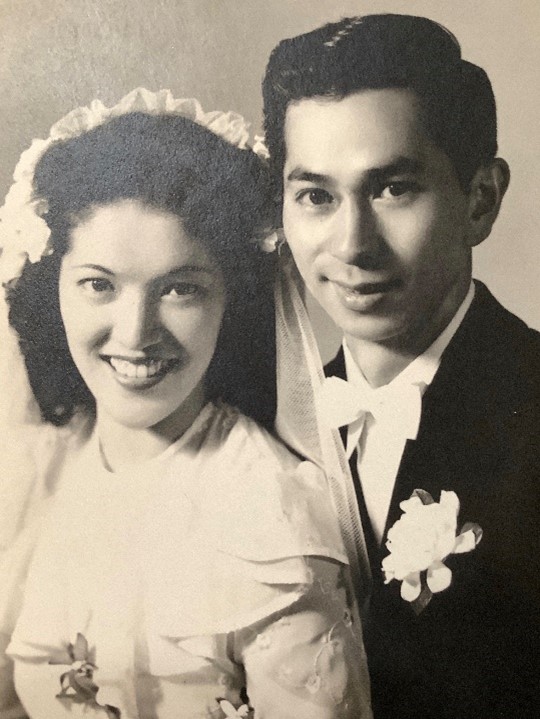
After the war, George settled in Chicago, where he married Doris Toshiko Kariya, the daughter of Mr. and Mrs. Arthur Hirokichi Kariya of Oakland, California. Doris and her family had been evacuated to the Tanforan WCCA Assembly Center in the spring of 1942. They were incarcerated at Topaz WRA Camp, entering on September 17. They were released by invitation to Chicago – Doris on November 11, 1943, and her parents on June 7, 1944.
Wedding photo of George and Doris
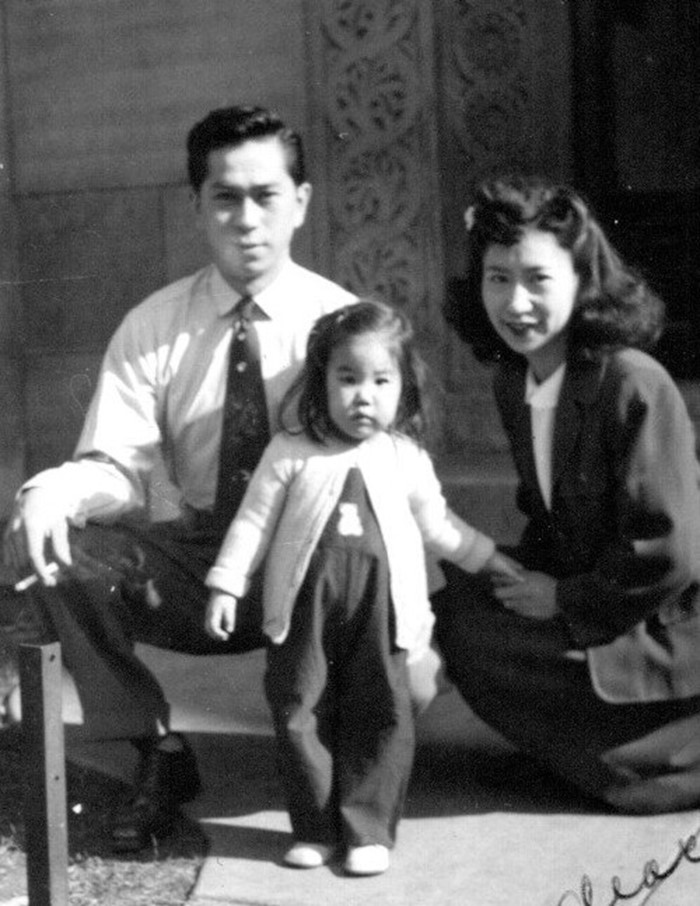
George with his sister and niece, 1946
By 1950, they were living at 4537 South Ellis Street with their 2-year-old son, George Jr. George was employed as a paint sprayer at a metal finishing company and Doris was a clerk at a local college. Over the years, they raised a family of one daughter and two sons. In 1955, George’s parents became U.S. citizens when they were naturalized on March 23 and December 6, respectively. George was a member of the American Legion in Chicago – Nisei Post #1183.
George Yaki died on November 26, 1997, in Palatine, a suburb in the northwest area of Chicago. His wife Doris died on March 25, 2000. Arrangements were made by Ahlgrim and Sons Funeral home. Their ashes were scattered in San Francisco Bay.
Researched and written by the Sons & Daughters of the 442nd Regimental Combat Team with assistance of George Yaki’s niece in 2022.
